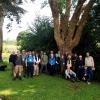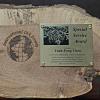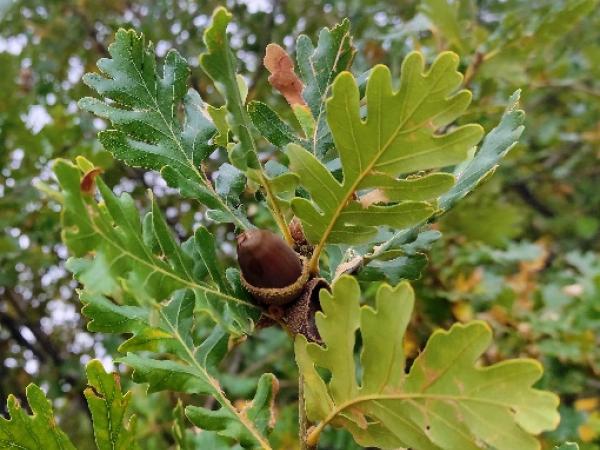Editor's Picks
Plant Focus
Ever since I was interested in oaks, there was one species most desirable for me, and for many other people interested in oaks: Quercus insignis M. Martens & Galeotti (1843), a rare White Oak species, reaching 15 to 25, but sometimes up to 40 meters in height, with a natural range including Central America (Belize, Honduras, Panama, Guatemala, Nicaragua, Costa Rica) and Mexico (Veracruz), at an altitude varying from 200 to 1,700 meters above sea level, and bearing the biggest acorns of any oak species.
 |
|
Q.insignis at Arboretum Chocha, Ustarritz, France. Mature leaves. |
I remember, when I was still a beginner in oaks, sending Guy Sternberg an email, asking if he knew a source for these gigantic acorns, after seeing on Google the picture of his hand holding just one of them – I guess we may have all seen that picture once. So he answered the email by telling me this oak was so rare and hard to find, I had to be satisfied with a grafted plant, if I was ever able to obtain scion wood. Of course I wanted that giant acorn, to be able to plant it myself and see the seedling develop.
I did some searching for acorns a couple of years, and I remember seeing great specimens during the 2012 Post-Tour, especially in Iturraran, and heard some great stories about how the acorns were obtained. But I was at a dead end. I was never going to find viable, fresh acorns!
Quite recently I came into contact with an oak collector in the United Kingdom, and he told me he had some Q. insignis seedlings in his collection, so I kindly asked if I could trade with him, and I was lucky! I finally got my Q. insignis – as a seedling, but hey, I was a happy fellow! After two weeks, I finally received the package from him, with my Q .insignis seedling and a few other oaks.
 |
|
Myself posing under Q. insignis,measuring 8 meters, at Jardin Botánico Iturraran. Photo: D. Keiser |
As I was unpacking the parcel, I soon came to realize the seedling was in very bad condition, and the root system was almost gone! It was a nightmare, after a couple of days the few leaves started to dry out, and I was worried if it was still alive. I emailed him, and I told him the story. He felt really bad about it and told me he might be able to get a few acorns from a contact he has in Spain.
After a month and a half I received an email, some Q. insignis acorns were on the way, and he was willing to give me two of them, together with a few acorns of oaks native in Spain – I couldn’t be happier!
 |
|
Q. insignis, actual size of an acorn, with my hand for scale |
So after a week, a second package from the United Kingdom arrived in my mail, and I saw the two fresh Q.insignis acorns, each the size of a golf ball, but unfortunately without a cupule. I put one in my hand and took some pictures. The funny thing was, my friends couldn’t believe this was an acorn, because acorns from our native Q. robur don’t exceed 4 cm in length and 2 cm in width. I was only worried about one thing: it was in the middle of winter, and one acorn had already sprouted in the moist tissue paper it was put in, so the radicle end was black!!
Next task: germinate a Q.insignis acorn! Though I was quite experienced in germinating acorns, a Q.insignis was something very new to me. Because of the size and its warm origin, I applied the same method I use to do with palm seeds (long before I was an oak hunter, I grew palm trees from seed) and it was a great success! The one acorn with the black, almost molded radicle soon began to regenerate roots, and made three radicles instead of just one. The other one started one month later.
 |
 |
|
The acorn I received with the black radical end soon began to regenerate its roots and made three new radicles at room temperature, keeping it in a moist piece of tissue in a ziplock bag |
|
After developing a root about 6 cm in length, I put one acorn in a 2.5-liter container to let it develop. I use deep containers, mostly used by rose and fruit-tree breeders.
After about two weeks, quite soon, the great moment arrived: the shoot popped above the soil! I had finally succeeded, it was developing fast, and within two more weeks it developed its first leaves. It’s one of the most colorful shoots of any oak, being bright green with a very dense covering of red hairs.
 |
 |
 |
 |
|
Various stages of leaf development. I took a picture almost every day! |
|||
At the moment the seedling is about 20 cm tall, and the leaves are about 15 cm in length, and 6 cm in width. It will soon flush again! I also learned that you must never underestimate the regeneration capacity of an oak, because even the seedling I received damaged in the mail began to grow a whole new shoot, after two months I had almost given up on it!
 |
 |
| Latest photos of Q. insignis (May 2015) | |
Photo credits: J. Braakman (unless specified)

















